Java String vs StringBuffer vs StringBuilder Example
1. Introduction
In this post, we feature a comprehensive article on Java String vs StringBuffer vs StringBuilder.
In an in-depth analysis we will feature how to create Strings and modify string objects using String class, StringBuffer class and StringBuilder class.
2. Java String vs StringBuffer vs StringBuilder
2.1 Prerequisites
Java 7 or 8 is required on the linux, windows or mac operating system.
2.2 Download
You can download Java 7 from Oracle site. On the other hand, You can use Java 8. Java 8 can be downloaded from the Oracle web site .
2.3 Setup
You can set the environment variables for JAVA_HOME and PATH. They can be set as shown below:
Run Command
JAVA_HOME=”/jboss/jdk1.8.0_73″ export JAVA_HOME PATH=$JAVA_HOME/bin:$PATH export PATH
2.4 Java String
In java, strings are objects. String class is used to modify and change strings. String objects are created by initializing the instance by using constructor and new keyword. new keyword creates an instance of a String class as an Object. The constructor takes an argument as a string and creates a String Object.String objects created will be part of the String Constant Pool.String pool is important for String creation as object allocation is expensive in both time and memory. The pool of strings is maintained to reduce the number of strings created in the Java Virtual Machine. String class is immutable. A String instance which is created cannot be modified. The String methods create the String objects and return a new String object as an output of the methods. Sample Code is shown how String class is used. The StringDemo shows taking a String and reversing a String which is a palindrome. The StringDemo class has a method reversePalindrome which takes the input palindrome string and returns the reversed String.
String Demo
public class StringDemo {
public String reversePalindrome(String palindrome)
{
int len = palindrome.length();
char[] tempCharArray = new char[len];
char[] charArray = new char[len];
for (int i = 0; i < len; i++) {
tempCharArray[i] =
palindrome.charAt(i);
}
for (int j = 0; j < len; j++) {
charArray[j] =
tempCharArray[len - 1 - j];
}
String reversePalindrome =
new String(charArray);
return reversePalindrome;
}
public static void main(String[] args) {
String palindrome = "Red rum, sir, is murder";
StringDemo stringReverser = new StringDemo();
String reversePalindrome = stringReverser.reversePalindrome(palindrome);
System.out.println(reversePalindrome);
}
}
The command below executes the above code snippet:
String Demo
javac StringDemo.java java StringDemo
The output of the executed command is shown below.

2.4.1 Concatenating Java Strings
String class has a concat method for appending two strings. Strings can be concatenated with the + operator. ConcatStringDemo class below shows the concatenation of strings.
Concat String Demo
public class ConcatStringDemo {
public static void main(String[] args) {
String firstString = "Red rum, sir, is murder";
System.out.println("first string "+ firstString);
String secondString = " added String";
System.out.println("second string "+ secondString);
String concatenatedStrings = firstString.concat(secondString);
System.out.println("concatenated String "+concatenatedStrings);
}
}
The command below executes the above code snippet:
Concat String Demo
javac ConcatStringDemo.java java ConcatStringDemo
The output of the executed command is shown below.
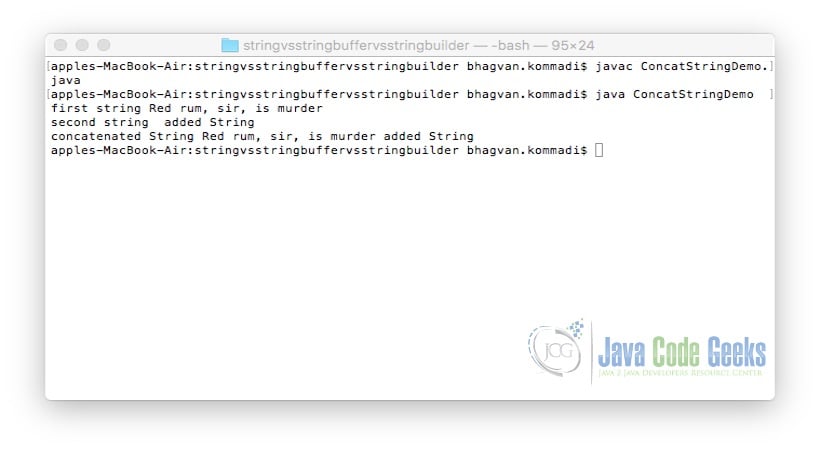
2.4.2 Formatting Java Strings
String class has format method which can take string which has integer, float, double and character data types. FormatStringDemo class shows below the formatting of the String which has integer, double and string data types.
Formatting String Demo
public class FormatStringDemo {
public static void main(String[] args) {
String formattedString;
int intVal = 3;
double doubleVal = 5.4;
String stringVal = "formatted String";
formattedString = String.format("The value of the int variable is " +
"%d, while the value of the double " +
"variable is %2.1f, and the string " +
"is %s", intVal, doubleVal, stringVal);
System.out.println(formattedString);
}
}
The command below executes the above code snippet:
Formatting String Demo
javac FormatStringDemo.java java FormatStringDemo
The output of the executed command is shown below.
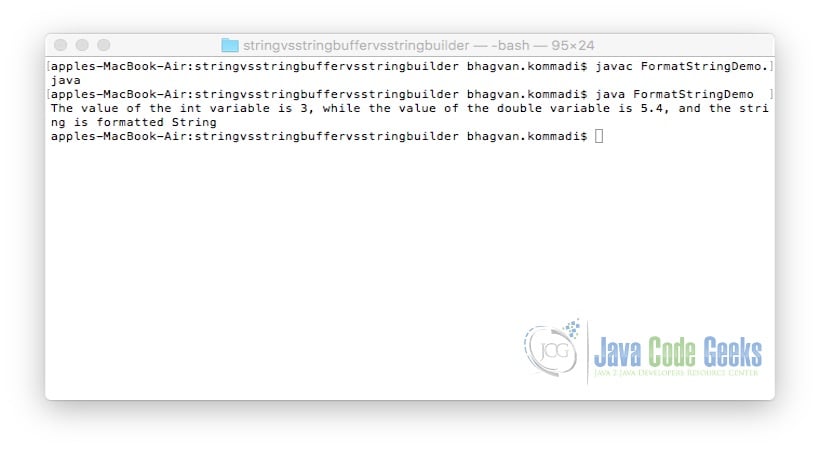
2.5 Java String Buffer
A StringBuffer cannot be changed like a String. It consists of a set of characters. StringBuffer methods are used to change the length and set of the characters in a String Buffer. Multiple Threads can access the String buffer and modify the String buffer simultaneously. String Buffer methods are synchronized and multiple threads can operate on the string buffer instance. StringBuffer has methods append and insert to modify the String. Sample Code is shown below how StringBuffer class is used.
String Buffer Demo
public class StringBufferDemo {
public StringBuffer appendString(String initial, String buffer)
{
StringBuffer sBuffer = new StringBuffer();
sBuffer.append(buffer);
return sBuffer;
}
public static void main(String args[]) {
StringBufferDemo stringBufferDemo = new StringBufferDemo();
String initial = "check the string";
System.out.println("initial String "+initial);
StringBuffer sBuffer = stringBufferDemo.appendString(initial," added string");
System.out.println(sBuffer);
}
}
The command below executes the above code snippet:
String Buffer Demo
javac StringBufferDemo.java java StringBufferDemo
The output of the executed command is shown below.
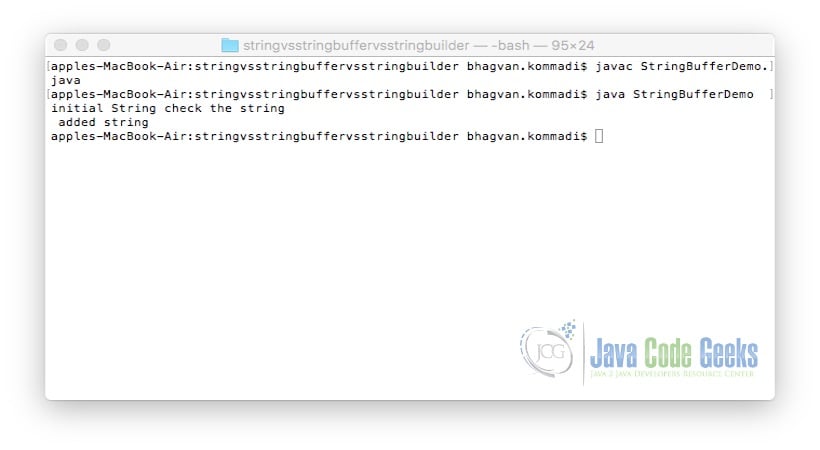
2.5.1 Creation of String Buffer
StringBuffer Class has constructors related to creation of StringBuffer by specifying size and by specifying the string. The below class StringBuffer CreationDemo shows the creation of StringBuffer using different Constructors.
String Buffer Creation Demo
public class StringBufferCreationDemo {
public static void main(String args[]) {
StringBuffer stringBuffer = new StringBuffer(30);
stringBuffer.insert(0,"buff");
System.out.println("after insertion "+stringBuffer);
StringBuffer sBuffer = new StringBuffer("created String Buffer");
System.out.println("string buffer"+sBuffer);
}
}
The command below executes the above code snippet:
String Buffer Creation Demo
javac StringBufferCreationDemo.java java StringBufferCreationDemo
The output of the executed command is shown below.
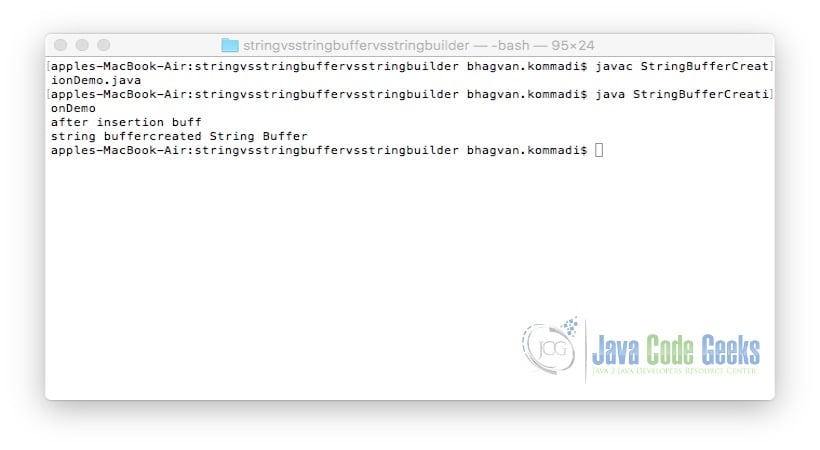
2.6 Java String Builder
StringBuilder class is used to build a mutable set of characters. StringBuffer is consistent with StringBuilder but synchronization is not guaranteed. StringBuilder can replace StringBuffer in scenarios which are single threaded. StringBuilder has the append and insert methods which can handle different types of data. This StringBuilderDemo class transforms the data into a string and adds or modifies the characters of the string in the StringBuilder. The sample code below shows how StringBuilder is used.
String Builder Demo
public class StringBuilderDemo {
public StringBuilder reverseString(String palindrome)
{
StringBuilder sb = new StringBuilder(palindrome);
StringBuilder reverse = sb.reverse();
return reverse;
}
public static void main(String[] args) {
String palindrome = "Red rum, sir, is murder";
StringBuilderDemo stringBuilderDemo = new StringBuilderDemo();
StringBuilder reverse = stringBuilderDemo.reverseString(palindrome);
System.out.println(reverse);
}
}
The command below executes the above code snippet:
StringBuilder Demo
javac StringBuilderDemo.java java StringBuilderDemo
The output of the executed command is shown below.
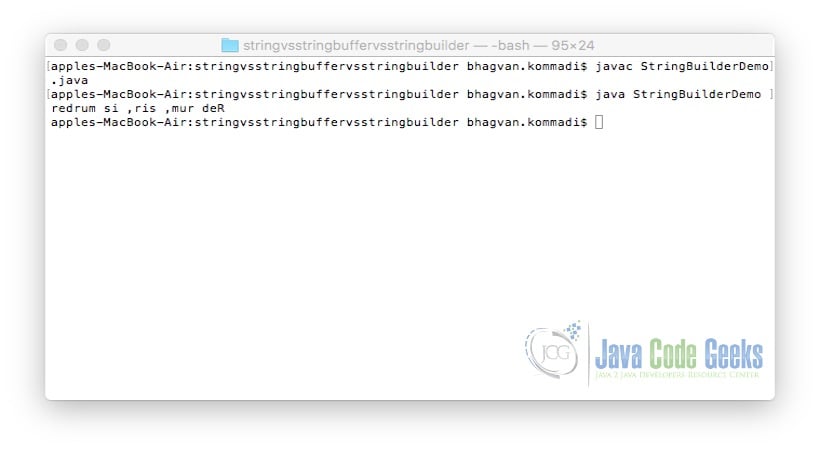
2.6.1 Creation of String Builder
StringBuilder class has constructors to create the instances of StringBuilder by specifying the capacity and by specifying the string. StringBuilderCreationDemo class is shown below to demonstrate the creation of StringBuilder Objects by using the constructors.
String Builder Creation Demo
public class StringBuilderCreationDemo {
public static void main(String[] args) {
StringBuilder stringBuilder = new StringBuilder("build String");
System.out.println("string built :"+ stringBuilder);
StringBuilder initializedStringBuilder = new StringBuilder(30);
System.out.println("initialized :"+ initializedStringBuilder);
initializedStringBuilder.append("added String");
System.out.println("built String after appending :" +initializedStringBuilder);
}
}
The command below executes the above code snippet:
StringBuilderCreation Demo
javac StringBuilderCreationDemo.java java StringBuilderCreationDemo
The output of the executed command is shown below.
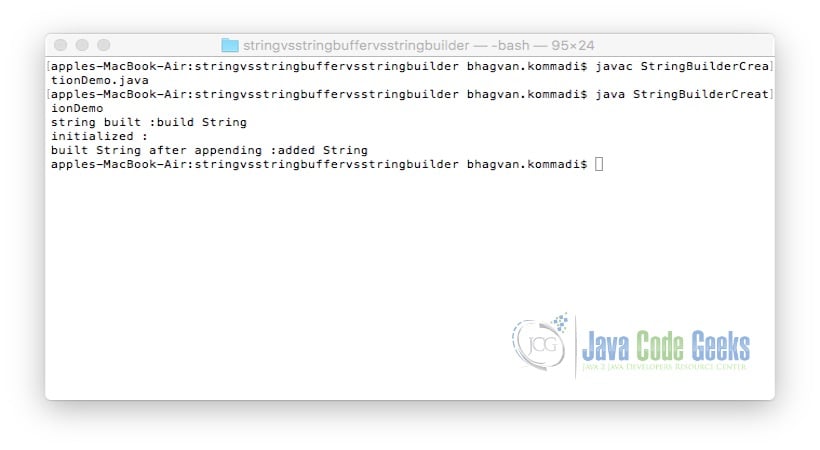
3. Download the Source Code
You can download the full source code of this example here: Java String vs StringBuffer vs StringBuilder


